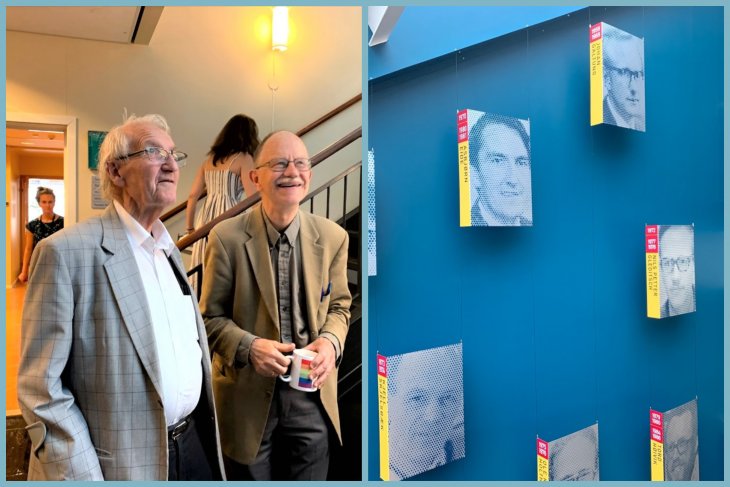
Asbjørn Eide and Nils Petter Gleditsch in 2019, admiring the younger versions of themselves as the ‘Directors Wall’ was unveiled during PRIO’s 60th Anniversary. Photo: Agnete Schjønsby / PRIO
Asbjørn Eide, interviewed by Helge Øystein Pharo
Former PRIO Director Asbjørn Eide was only seven years old when he experienced war at first hand. In a surprise attack on the morning of 9 April 1940, the Germans began to invade Norway. As a result, Norwegian forces in the Bergen area retreated eastwards towards Voss. At Bulken, the Germans were temporarily halted. They retaliated by firebombing Vossevangen. Within a few days, the Eide family found the situation so precarious that they left for Eksingedalen, somewhat west of Voss. After two days of walking through deep snow, they reached the family farm. In retrospect, Asbjørn Eide muses that his interest in the causes of conflict and how they may be prevented can probably be traced back to that harrowing experience of April 1940.
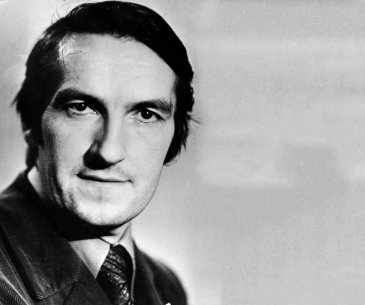
Asbjørn Eide in 1973. Photo: NTB scanpix
Asbjørn Eide came to PRIO as director in 1970 and worked at the institute until 1987. In 2018, I met with Asbjørn Eide in a temporarily vacant office at PRIO in downtown Oslo. We were greeted by younger PRIOites who appeared pleased at the appearance of two old timers joining forces at the Institute.
Helge Øystein Pharo: I understand that your family remained at Voss for the duration of the War and then moved east in 1946, settling in a rural area, Jessheim in Ullensaker, an hour or so north of Oslo. What was school like in these new surroundings?
Asbjørn Eide: I completed primary school at Hovind school in Ullensaker, and then went on to a local junior high school (realskole). At the time there was no senior high school (gymnas) in the area where we lived, so I applied to and was accepted at Eidsvold Landsgymnas.
Eidsvold was too far away for me to live at home. I had to move there and rent a room there, as did most of the other students at Eidsvold. My parents were not well off, so I did struggle a bit to get by. I was awarded some modest scholarships and worked during the summers. All things considered, it worked out quite well. I graduated in 1952 as preseterist [from the Latin prae ceteris, praiseworthy above others].[1]
Eidsvold was clearly intellectually stimulating. Did it also impact your thinking about issues of war and peace?
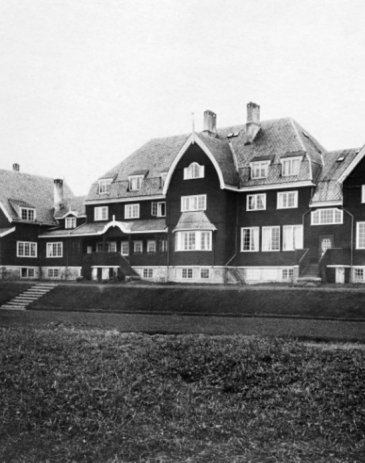
Eidsvoll landsgymnas. Architect: Arnstein Arneberg
Yes, the milieu encouraged intellectual debates both in class and in the student extracurricular clubs and the student assembly (gymnassamfunnet). As for my later academic interests, I remember an episode where we discussed the Korean War (1950–1953), where I was supposed to have pronounced that the Americans would fight to the last Korean. I was very critical of the war and the role of the Americans in particular. However, the debates that took place, in particular in the student assembly, were pursued in an orderly and academic fashion. The years at Eidsvold quite clearly reinforced my interest in issues of war and peace. By the way, it dawned on me in later years when teaching in Washington D.C. and visiting the Korean War Memorials that this war was quite traumatic also for the Americans.
Pre-PRIO Career
Did you go straight from high school to studying law?
No, I joined the Army for 16 months of compulsory military service and spent one year in Germany in the Norwegian brigade that was part of the British occupation forces during 1952–53. The brigade was based in Flensburg close to the Dano-German border. That city was only moderately damaged, but even so we gained a clear understanding of the devastation caused by Hitler’s war, and the poverty and distress that reigned in the occupation zone. Hamburg was something else, a city that had completely collapsed in ruins. After returning from the military I worked for a while as a lumberjack in the Løvenskiold forests far north in Nordmarka [the woods adjoining Oslo to the north] to finance my studies, and also as a bank clerk in the summer. I started law school in the autumn of 1954.[2]
When you started your undergraduate studies, were you then particularly concerned with international law and those fields that were later to be at the forefront for you as a researcher and teacher?
No, not really. Starting out I was primarily concerned with finishing my studies on time. Subsequently I was drawn into student politics, and was elected leader of the Norwegian Student Union [at the time Norsk studentsamband, Norsk studentunion since 1964], a national organization created in the interwar years to cater for the interests of students at Norwegian universities and colleges. In 1961, the year after I completed law school, I was elected president of the Oslo University Student Assembly (Det norske studentersamfunn) [founded 1813], representing a centre-left coalition of two different socialist student associations, the Liberal student association and a number of political independents.
After your graduation in the spring of 1960, you worked in the Ministry of Justice for a year?
Yes, I graduated at the top of my class, and was hired to fill a temporary position in the Legal Division of the Ministry. This is one of the most sought-after places to work for aspiring jurists. I had, however, no desire to remain there.
The following year, the Law Faculty at the University of Oslo approached me to enquire whether I would be interested in a position as university lecturer. I held this position from 1962 to 1965.[3] From 1965 to 1969 I held a University Fellowship, and during that period spent one year at the Royal Institute of International Affairs in London and one year at Columbia University in New York. While in the Legal Division I worked on strictly Norwegian legal questions, so it was only in the following years that I moved into international law and human rights issues in particular.

Torkel Opsahl (1931-1993). Photo: University of Oslo
I was strongly influenced by Torkel Opsahl, whom I suppose may be considered my mentor.[4] The two of us shared an interest in human rights and the role of international organizations in promoting and protecting human rights. At the time, I was particularly concerned with UN peacekeeping operations, and subsequently with international human rights protection. Torkel was a member of the Human Rights Commission of the European Council and subsequently also of the UN Human Rights Committee. I believe he is the only one to have been a member of both. We also both engaged in the struggle against nuclear weapons in the early 1960s, and jointly authored the article ‘Atomvåpnene i folkeretten, i FN og i NATO’ [‘Nuclear weapons in international law, in the UN and NATO’].[5] Our cooperation lasted until his untimely death in 1993.
Attitudes to the Cold War
First, let me ask: Despite your scepticism to – or rather opposition to – nuclear weapons, you were never an outright opponent of Norwegian NATO membership?[6]
No, I was not actively engaged against membership, but I was certainly a sceptic. I tended to see the alliance as creating conflict rather than preventing it by means of deterrence.
Many years later, when I started to study in depth the dual origins of the Cold War, I came to understand more fully the origins of both NATO and the Warsaw Pact, NATO’s opponent involving Central and Eastern Europe.
I trace it back to January 6, 1941, when the newly re-elected President Franklin Roosevelt held his State of the Union address to the US Congress. There were two messages in that address, and the final part is the most celebrated. That final part contains the visions of a new world order to be created when World War II comes to an end. That part was subsequently followed up by the Atlantic Declaration, resulting from a meeting between Roosevelt and the Prime Minister of Great Britain in August 1941 and later pursued through the Declaration of the United Nations [a term chosen by Roosevelt] on January 1, 1942.
This became the origin of the United Nations, which initially was an alliance between the states that fought the Axis [consisting of Mussolini’s Italy, Hitler’s Germany and the militarized and aggressive Japan together with some minor European powers].
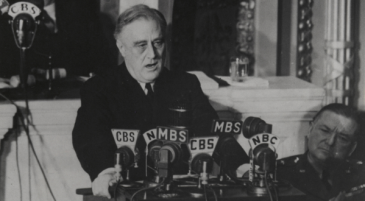
President Roosevelt giving his State of the Union Speech in 1941. Photo: Franklin D. Roosevelt Presidential Library and Museum
The crucial point in this context is that when the United Nations was established at the San Francisco conference in 1945, one of its main purposes was – and is – to develop international cooperation in solving problems of an economic, social, cultural, or humanitarian character, and in promoting and encouraging respect for human rights and fundamental freedoms for all without distinction as to race, sex, language, or religion, and to be a centre for harmonizing the actions of nations in the attainment of these common ends.
It is on that basis that the United Nations has developed a comprehensive international human rights law, and it is to that purpose that I have devoted the main part of my academic and professional life.
The main part of Roosevelt’s State of the Union address in January 1941 dealt with something entirely different: his efforts to persuade the US Congress to facilitate and finance a substantial armament build-up to be made available both to the US armed forces and to those in need when resisting aggression. He proposed to establish what he called ‘the arsenal of democracy’.
Since then, the United Nations has grown from encompassing 58 independent and sovereign states to 193 sovereign states, many of whom are not very democratic. To reach the intended aim of the Universal Declaration of Human Rights becoming a common standard of achievement is a long and tortuous road, but in my opinion very much worth pursuing.
The United States’ ‘arsenal of democracy’ has grown enormously, and recipients have not always been democratic. On 20th June 1941, Hitler’s Germany launched Operation Barbarossa. The US supplied the USSR with armaments under the ‘lend and lease’ act. The Soviet Union, on its side, took steps from 1944 to Sovietize Central and Eastern Europe. In the US, atomic weapons were created under the Manhattan project, and World War II came finally to an end through the dropping of atomic bombs on Hiroshima and Nagasaki. The ‘arsenal of democracy’ might from then on be perceived as a threat for the whole world.
The arms race appeared to have no end, and when the Soviet Union got the bomb, things just got worse. I and other activists who shared my views were preoccupied with the question of how to counteract the arms race. We literally thought the MAD doctrine (Mutual Assured Destruction) was just that. We considered the balance of terror inherently unstable and feared that the arms race would end only when the parties to the East-West conflict had obliterated one another.
We considered the balance of terror inherently unstable and feared that the arms race would end only when the parties to the East-West conflict had obliterated one another. This was one of my main concerns when I joined PRIO.
This was one of my main concerns when I joined PRIO. Peace researchers were doing important studies on the dynamics of the arms race in order to increase the public awareness of a potential nuclear war. On the one hand, I had a hope that peacekeeping could prevent the great nuclear powers from becoming involved in major wars, and on the other hand that the promotion of human rights could help stabilize the new states emerging out of colonization (1960–1970) and that central and Eastern European countries could be liberated from the USSR’s imperial/socialist design, which these states did in 1989–1990.
I suppose, then, that you also shared other views held by the Norwegian foreign policy opposition, which gradually evolved from the 1950s and were to become part and parcel of Norwegian foreign policy, such as development aid, support for decolonization, and the struggle against Apartheid in South Africa?
Yes, that is absolutely the case. For a while I chaired the Norwegian Anti-Apartheid movement.[7] As for decolonization, in the early 1960s I started my work on the UN peacekeeping operations.[8] I was particularly interested in the Congo conflict and how Western states and companies tried to maintain their positions in their former colonies. Prominent among them was the Belgian company Union Minière (UNIMIN) in Katanga. UNIMIN played a most negative role in the new state, and may even have been partly responsible for the crash of the airplane carrying Secretary General of the UN, Dag Hammarskjöld. At that time, and on several later occasions, I had contact with the Norwegian military officer Bjørn Egge, who had spent time in the Congo in his capacity as intelligence specialist and worked there to establish an intelligence arm of the UN peacekeeping forces.[9]
The New International Economic Order (NIEO)
As I understand it, you have maintained your interest in the economic development of new states in the post–World War II era, in terms of development aid and more broadly North-South relations? And I understand that you are strongly of the opinion that economic development is a prerequisite for institutionalizing and securing human rights?
I think this has to be discussed in somewhat separate parts. In the first place, I have long been concerned with human rights and our relationship with the new states. And I have analyzed the demand for a New International Economic Order from a human rights perspective. I am absolutely of the opinion that the observation of human rights is a precondition for development. This must be linked to the fact that when, from the mid 1960s, the demand for a NIEO was raised partly because the terms of trade between the industrialized states and those wanting to industrialize were extremely unfavourable for the latter.
The NIEO may also be seen as a matter of justice. As for human rights in what used to be called the Third World, I have maintained my interest. I noticed Steven Jensen’s recent book and his emphasizing the role of Jamaica in promoting both decolonization and human rights within the UN.[10]
Norway was an early enthusiast for development aid and launched a project to India in 1952. By the early 1970s, in terms of relative aid contributions, Norway had moved to the forefront of donors together with Denmark, Sweden and the Netherlands – the so-called ‘likeminded states’. PRIO researchers were enthusiastic, if at times critical, supporters of Norwegian aid policies, and even wanted to proceed further along the road to the NIEO, and to see Norway more quickly dismantle protection against Third World exports, from shipping to textiles.
I, along with most historians dealing with Norway and the NIEO, was quite sceptical of on the one hand Norwegian willingness to dismantle protectionist measures and on the other of the possibility for the NIEO to be accepted by the major Western powers. This was our view of the possibilities even before Margaret Thatcher became British prime minister in 1979 and Ronald Reagan was elected president of the United States in 1980.
During an interview I made with Thorvald Stoltenberg, at different times a Labour Party Secretary and Undersecretary of State, he acknowledged the protectionist problem. He still maintained that he did believe in the NIEO until Thatcher and Reagan. Did you think the NIEO was within reach before the conservative/liberalist wave starting in the late 1970s? Did you see the discrepancy between NIEO support and Norwegian protectionism?
As many academic NIEO supporters, I obviously noticed the discrepancy between Norwegian principles and Norwegian protectionism. As most Norwegians working in this field, I realized that increasing transfers was easier than dismantling quotas and tariff barriers and other kinds of protection for Norwegian industries.
On the other hand, I was persuaded until Thatcher and Reagan that NIEO was conceivable. I believed that even the Americans and the Germans, as a result of civil society pressure, would eventually come to accept the NIEO. Of course, I don’t know the details of Thorvald Stoltenberg’s reasoning, but I think that both he and I essentially thought that international public opinion would in the end tilt even the major powers towards a version of the NIEO.
Reagan and Thatcher were instrumental in putting an end to the dreams of a new economic world order, but, of course, the process was helped along by the debt crisis of the 1980s, and Mexico’s default. I did not write much about those issues at the time. I have since discussed the different stages of globalization, economic development and the need for increasing standards of living in the new states as preconditions both for the observance of human rights in these states and for the development of a more peaceful international society. At the same time, I have become increasingly concerned with promoting an understanding that these are not fully developed states, and that these processes inevitably take time.
So over the years you have reached more sober conclusions as to what may be achieved in the short run with regard to both human rights and economic development in the new states?
Yes, I am afraid so. The problems of development and human rights were immensely complicated in themselves, and were aggravated by the machinations of both the great powers and multinational companies promoting their own interests during and certainly also after the Cold War.
Specializing in Human Rights
You have worked widely in the field of international human rights – as a scholar, as an activist and as a member of numerous international commissions?
Yes, that is true. A number of influences put me on this road. While I held the university fellowship I completed a major paper on the international human rights system and the consequences that ratification of these conventions had for Norway.
This work would form part of the basis for the work I did that led to Stortingsmelding 93 (1976–77), which was the first government white paper ever on Norway and international human rights. Foreign Minister Knut Frydenlund had initially wanted Torkel Opsahl to do it, but he could not find the time, so he asked me instead to prepare the general background paper on the international system of protection of human rights.
In retrospect, I believe that this work was what put me firmly on the path to being a human rights scholar and activist. Torkel and I had also cooperated in preparing the 7th Nobel Symposium in 1967, which Torkel had proposed. This symposium brought together a number of key persons working on human rights issues. I was asked to be the rapporteur of the symposium and to produce the book, which I edited jointly with the Director of the Norwegian Nobel Institute, August Schou.[11]
Of course, my year at Columbia University had kindled my interest in human rights issues as well. Columbia was home to many human rights scholars. I made quite close contact with Leland Goodrich, who in 1949 together with Edvard Hambro published the Charter of the United Nations: Commentary and Documents.[12] I also over the years was in quite close contact with Hambro.
As regards the importance of human rights for peace research, I find it pertinent to point out that the Preamble to the Universal Declaration on Human Rights states very clearly that human rights require protection by law in order that man in the last resort shall not be forced to rebel against tyrants and repression. The rule of law and democracy must be promoted.
I had become convinced that in order to come to grips with the manifold internal conflicts in many parts of the world, the promotion of human rights was one important avenue. I wanted to understand societal change and how to influence it. I wanted to convert my academic learning into socially useful work.
At quite an early stage, I established close and extensive contact with Amnesty International and its Secretary General Martin Ennals (1929–1991). We joined forces to put together a system of documentation regarding human rights. We named it Huridocs, Human Rights Documentation System. I had become convinced that in order to come to grips with the manifold internal conflicts in many parts of the world, the promotion of human rights was one important avenue. That gave meaning to the work I had engaged in. I wanted to understand societal change and how to influence it. I wanted to convert my academic learning into socially useful work.
Human Rights in International Affairs
How closely were you involved in the formulation of Norwegian responses to the Helsinki process from 1975 onwards?
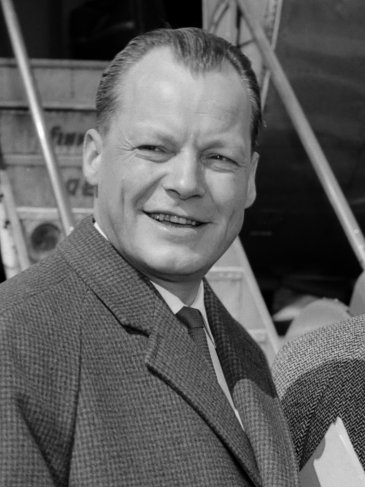
Willy Brandt in 1959. Photo: Nationaal Archief, Netherlands. CC0
I considered the Helsinki process a most constructive one. The initiative was Willy Brandt’s through his Ostpolitik. We had, of course, a particular affinity for Brandt because of his past as an almost Norwegian, a political refugee from Hitler’s Germany to Norway in the 1930s, and then later Mayor of West Berlin and German Chancellor and leader of the Social Democratic Party. We greatly appreciated his efforts, and discussed it quite frequently with Jan Erik Helgesen (1947–), who was the one of us who most frequently attended the Helsinki process meetings.
Torkel Opsahl, Jan Helgesen and myself constituted a trio of jurists who were strongly engaged in the human rights issues, and who provided the Foreign Ministry with much needed expertise in the field. My recollection is that Jan was the key person on our part, even though at a later stage I also cooperated closely with Bjørn Engesland (1961–), who was later to become Secretary General of the Norwegian Helsinki Committee.[13] Helgesen was very much part of the post-Helsinki processes on the part of Norway.
As for myself, I was quite active in the processes at the tail end of the Cold War. I had some very interesting sojourns in Moscow during the Gorbachev era, as the Russians also looked to Scandinavia as a model for an alternative socio-political system. But then, of course, came Boris Yeltsin and Vladimir Putin. Frequently what we think would be desirable for others does not come to pass.
But, I will say, we were immensely cheered by the election of Jimmy Carter to the US presidency in 1976, and by his advocacy of human rights. He was a most welcome antidote to his Republican predecessors Richard M. Nixon (1969–74) and Gerald Ford (1974–77). The former in particular had engaged in close cooperation with reactionary and extremist political forces in South America, Chile first and foremost. In our opinion, Carter converted the efforts for the promotion of international human rights into a basic principle in international politics, and clearly forced the pace of the international efforts to promote human rights.
I have supervised two MA students who did their theses on Norway and the Helsinki process. Both of them found that Norway was at best quite diffident with regard to human rights in the Soviet Union and the eastern bloc more generally. However, as you were not really into the Helsinki process negotiations, we shall not pursue that question. I think we should rather proceed to look at your role in other fields of international human rights efforts, and the role of the threesome: Opsahl, Helgesen and yourself.
Opsahl, as I said, was very broadly engaged in international human rights work, both as an academic and as a member of both the European Council Human Rights Commission and the UN Human Rights Committee – I believe he is the only one to have been a member of both. As I mentioned, he died suddenly in 1993 in Geneva, while working on the investigations of war crimes in the former Yugoslavia. He was also the first chair of the Board of the Norwegian Human Rights Institute.
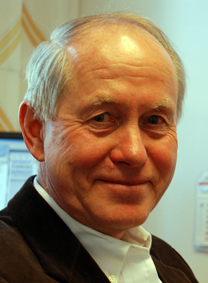
Jan Helgesen. Photo: University of Oslo
Jan Helgesen has kept working on human rights issues in Europe, and in particular in the former Soviet bloc. He is a member of the Norwegian Centre for Human Rights while also attached to the Faculty of Law at the University of Oslo.
As for myself, I proceeded along several different tracks. I kept up cooperation with Torkel Opsahl and Jan Helgesen regarding research, teaching and documentation of human rights issues within a Norwegian context. After a major UNESCO conference in Vienna in 1978, the three of us launched what we called the ‘Norwegian human rights project’. This would eventually lead in 1987 to the establishment of the Norwegian Human Rights Institute [which later became a Centre under the Faculty of Law, University of Oslo]. I shall return to that.
Furthermore, as I have already mentioned, I was involved in work with Amnesty International, and attended some Pugwash conferences, also with Sean McBride who was awarded the Peace Prize in 1974 for his efforts in Amnesty and for human rights work more generally.
NGO work was important to me. However, my main preoccupation was with three international institutions: The International Human Rights Institute in Strasbourg; the UN Sub-Commission for Human Rights; and the European Council’s Advisory Committee for the protection of minorities. The International Human Rights Institute was established in 1968, with the initial funding coming from Rene Cassin’s Nobel Peace Prize award that same year. I came to that Institute by way of my close contact in UNESCO, the Czech refugee Karel Vlasek. He was a student in Paris at the time of the Prague coup in 1948, and he immediately jumped ship and came to work for UNESCO. He took the initiative for setting up the Strasbourg Institute, which has been broadly engaged in teaching within the field of human rights. I have myself taught there. Strasbourg was selected to be the site for the Institute because that is where the European Council’s human rights efforts are concentrated. Vlasek had a very wide-raging network of contacts, which over the years has been very useful for me. As we are living in quite a small world, I assume that Torkel Opsahl was the Nobel Committee consultant who wrote about Cassin.
Minorities and Indigenous Peoples
From the early 1980s, I engaged ever more strongly in questions concerning the rights of minorities and indigenous peoples. In 1981 I was selected to be a member of the Sub-Commission on Prevention of Discrimination and Protection of Minorities, more commonly known as the UN Sub-Commission for Human Rights. It was composed of 27 academic experts distributed regionally between Western Europe and others (including the US, Australia, New Zealand, Latin America, and Africa.
I was re-elected to the UN Sub-Commission several times so I was a member for some 20 years, and in hindsight these were the most productive years of my life. The Commission developed into what in reality was a think-tank on human rights within the UN system. The members were mostly, but not exclusively, experts who acted independently of their own national states. The rest of us put some mild pressure on those who did not.
While a member of the Sub-Commission, I proposed that the UN establish a working group for issues related to indigenous peoples, and I was elected its first chair in 1982–83. When after the end of the Cold War and the collapse of the Soviet Union many serious ethnic conflicts broke out, I produced a study for the Sub-Commission on “peaceful and constructive ways to solve minority problems”, where I had great benefits from my intimate knowledge of peace research.
As a consequence of my report, the UN established a working group for the protection of minorities, which I chaired from 1995 to 2004. For a period, I also chaired the European Council’s Advisory Committee for the protection of minorities. Much of my subsequent research is based on the insights gained as chair of those committees at the UN and the Council of Europe.
You were at the centre of processes dealing with indigenous peoples and minorities in the UN and the European Council for nearly 30 years. In your own opinion, to what degree was this position due to your own interest and engagement in these issues, and your academic qualifications in particular, and to what degree do you think that it was due to Norwegian political involvement?
In other words, to what degree do you think the Norwegian Foreign Ministry pushed your candidacy for these positions?
As in many such instances, I believe it to be a matter of both. My academic qualifications and my engagement, my belief that such conflicts had to be dealt with both for the benefit of the peoples directly concerned and for the broader issues of peaceful development, were clearly very important.
To what extent the Norwegian Foreign Ministry as such pushed my candidacy, I don’t really know. I am quite sure, however, that Jan Egeland, first in his capacity as personal adviser to Foreign Minister Thorvald Stoltenberg, and later as Under-Secretary of State at the Ministry, played an important role in these matters. Egeland in the 1980s had been a key person at the Henry Dunant Institute in Geneva, as well as in Amnesty International. I strongly believe he played a crucial role in promoting my candidacy once he was in a position to do so.[14]
The Accidental PRIOite
This interview is undertaken on the occasion of PRIO’s 60th anniversary, so I believe it is time we return to your career at PRIO, and not the least to the question of why you joined PRIO in the first place.
Furthermore, how did your main research interests fit in with mainstream PRIO interests? Finally, we should touch upon your decision to leave PRIO for the new human rights institute.
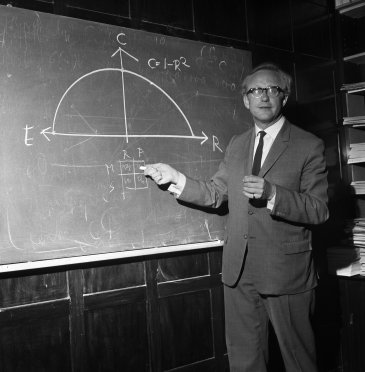
Johan Galtung lecturing in 1968.
Foto: Henrik Laurvik / NTB / Scanpix
First, to set the stage, so to speak. From about the mid-1960s, I did attend a number of PRIO seminars that I found quite exciting. I thought Johan Galtung a most engaging lecturer, but did not really get to know him at that time. I also found the activities of the so-called Peace Academy quite interesting. These were lectures taking place at PRIO, partly by PRIO researchers and partly by outsiders. The Peace Academy was not a PRIO activity proper, but run by the activist and actor couple Sonja Lid Larssen (1933–) and Lars Andreas Larssen (1935–2014). They were highly motivated and extremely energetic, Sonja in particular. A wide range of people attended, one of them being Bjørn Egge with whom, as I said, I had discussed UN peacekeeping operations.
At that time, my research interests were fairly closely aligned with mainstream PRIO interests, such as UN and peacekeeping operations, the linkage of war, conflict and poverty, and nuclear weapons and the arms race. My interest in human rights and international law possibly set me a bit apart, but not significantly so.
What prompted me to join PRIO was not, however, my research interests. My move there was due to the fact that Johan Galtung in 1969 was appointed to the recently established chair in peace and conflict studies at the University of Oslo. PRIO then needed a new director to replace him, and Galtung asked me to take on the job, even though we hardly knew one another.
I must confess that I was a bit surprised when I read this in Gudleiv Forr’s presentation of this transfer of responsibility.[15] You had no previous PRIO engagements or experience and your academic interests did set you a bit apart from mainstream PRIO.
On the other hand, as I mulled it over a bit, it dawned on me that other initial members of PRIO had gone elsewhere by this time. Arne Martin Klausen to the Ethnographic Museum and Mari Holmboe Ruge to the Research Council. Thus, I concluded that PRIO at a turbulent time needed a steady hand at the helm. Even so, I wondered: why not Nils Petter Gleditsch? He is an extremely well-organized person.
I suppose I had the reputation of being a capable administrator as well as researcher. There were many enthusiasts at PRIO, and not all of them equally well organized. As for Nils Petter, he certainly was. Whether Johan had asked him to take over, I really do not know. It is, of course, conceivable, and it is equally conceivable that Nils Petter would have replied that he would rather concentrate on his research, where he has indeed excelled.
Possibly, it had to do with age as well as proven experience. At 37, I was considerably older than the new cohort of PRIO researchers, such as Nils Petter Gleditsch, Kjell Skjelsbæk, Tord Høivik and Helge Hveem. They were all in their late twenties. Galtung, of course, had been very much an absentee director, travelling the world. It was to a degree a matter of establishing administrative routines and financial control, making sure everything was running properly.
Even so, trying to run PRIO must have been quite challenging in the 1970s and into the 1980s. You were director in 1970 and institute leader from 1980-81. Your second time around was at a particularly turbulent time, in the aftermath of the Loran-C case and with the ongoing Gleditsch/Wilkes case?
I had actually forgotten about my term as institute leader. It is some time ago, after all. We all faced the turbulence, institute leaders, researchers and support staff. Some of the conflicts were of a serious character for both individual researchers and the Institute, others less so. Some were entirely of our own making, others only partly so, where outsiders fanned the flames.
To a degree, I believe the turbulence was due on the one hand to the pursuit of research projects that were politically easily flammable, and on the other hand to the willingness of outside critics to use such projects to undermine PRIO’s existence altogether. At that time, peace research was still a field that provoked criticism from many quarters.

A somewhat peculiar decision-making system… Asbjørn Eide to the left, Johan Galtung to the right.
Our somewhat peculiar decision-making system – with the strong role of the general meeting, and not the least the flat wage structure – were problems we created for ourselves. On the other hand, these were pet concerns of the academic left at the time, and, however peculiar they may appear in retrospect, they were symbolically important. Despite quite pronounced misgivings, we all tagged along for quite some time, probably much longer than was sensible from an institutional point of view. Eventually, in the 1980s, PRIO transformed into an institution more like the other independent research institutes.
I believe the turbulence was due on the one hand to the pursuit of research projects that were politically easily flammable, and on the other hand to the willingness of outside critics to use such projects to undermine PRIO’s existence altogether.
However, you are of the opinion that research-related issues were more important, and that the turbulence was due as much to outside detractors as to the actual research projects themselves?
PRIO was – and not entirely without reason – characterized as politically quite leftish, and it was a widespread assumption among conservatives and more middle-of-the-road politicians and academics that the political preferences of the researchers tended to influence at least the topics chosen and possibly even the outcomes of research projects. Such was presumed to be the case with the Wilkes-Gleditsch project, and Anders Hellebust and Loran-C and Omega. It could be said also to extend to the critical analyses of Government and Labour policies with regard to EC membership, and Helge Hveem’s investigation of Borregaard in Brazil.
Yes, many detractors tended to see these projects as at least politically motivated, and a smaller number considered them more as politics than research. My view, now as then, boils down to the idea – and this concerns mainly Wilkes-Gleditsch and Loran-C/Omega – that it was important for Norwegian public opinion to be properly informed about Norwegian foreign policy and intelligence operations.
PRIO and I were firmly in favour of more openness. Research in these areas is perfectly legitimate. We thought that, even if there are processes and issues that may require a certain degree of secrecy, in these cases the need for secrecy was considerably overrated. Different assessments of the need for such secrecy in intelligence gathering and foreign policy making constituted the basis for one of my few disagreements with Bjørn Egge. The occasion was a lecture on the Pentagon Papers. Bjørn was very critical of the Pentagon Papers process and its release of secret information.
In the PRIO case, the thing to worry about was not, in my opinion, the research projects themselves, but the fact that critics of PRIO would exploit these projects to scale down funding or altogether eliminate PRIO from the Norwegian social science research map. Thus, as I saw it, our main concern was to strike a balance between a principled support for openness and access to relevant data, along with the institutional caveat that this not be carried so far as to constitute a threat to PRIO’s existence.
PRIO certainly was for many years an irritant to the establishment, even as most of the political establishment generally favoured peace research, and was not beyond basking in the pleasant sunshine of promoting such research, as Eva Fetscher has documented in her doctoral dissertation.[16]
On the other hand, even as PRIO has become more mainstream and increasingly taken on commissioned work for the Foreign Ministry, clashes have occurred at lower levels, concerning both the role of Ministry officials at the time of the establishment of the state of Israel and later regarding the Middle East peace process. In these cases, the butt of criticism has been Hilde H. Waage. These wrangles are of course more about the actions of officials than about Norwegian foreign and intelligence policies, but they still concern issues of openness and accountability.
I was no longer at PRIO at the time of these important fights over openness. They were also less about the institution and more about the individual researcher. I certainly admire her work, and both then and now found the reactions of the Foreign Ministry officials somewhat misguided. As you say, even if these confrontations were at a different levels, they were about openness and accountability. Fortunately, at least in the first instance, they did relent, even if not always gracefully.
As we have touched upon, the political parties of the left and the centre-left were generally supportive of PRIO and peace research. At times they basked in its glow. Yet when push came to shove, political support was at times somewhat shaky, and PRIO activists were not necessarily very helpful.
On the other hand, PRIO had some avid supporters in academia. Gudleiv Forr deals at some length with what he dubs ‘the gentlemen’s club’ (herreklubben), and Eva Fetscher has also analyzed its role in her dissertation. Did you find it as useful as Forr and Fetscher have presented it?
Yes, the academic gentlemen (and women) were indeed very helpful. First and foremost, they included some law professors, such as Anders Bratholm and Thorstein Eckhoff. They functioned more as supporters in difficult times than as contributors to making PRIO policy, though they were most supportive at the time when the University of Oslo chair in peace and conflict studies was to be filled for the second time after Galtung resigned in 1979. All things considered, however, they were more protectors in times of trouble than actual policy-makers.
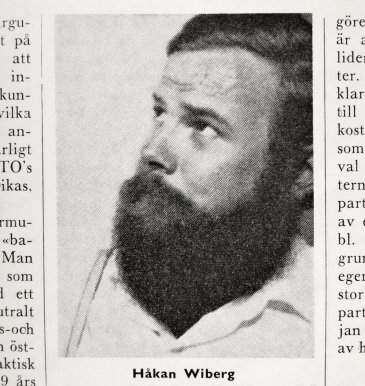 As for the chair and Galtung’s role at the University and at PRIO after he left, I do not recollect that we were disappointed that Johan did not include PRIO more in what was going on at the University at Blindern. He had always been on the move, so the change was not dramatic. However, after Johan resigned from the chair and Øyvind Østerud in 1980 was appointed to succeed him, disappointment was palpable. We had all rooted for Håkan Wiberg (1942–2010). We recognized that Øyvind was an excellent scholar, but we thought that his motivation to engage in applied peace research was somewhat lacking. We were right of course. He was definitely more of a detached international relations scholar than an activist peace researcher. The gentlemen’s club engaged quite strongly on the part of Håkan.[17]
As for the chair and Galtung’s role at the University and at PRIO after he left, I do not recollect that we were disappointed that Johan did not include PRIO more in what was going on at the University at Blindern. He had always been on the move, so the change was not dramatic. However, after Johan resigned from the chair and Øyvind Østerud in 1980 was appointed to succeed him, disappointment was palpable. We had all rooted for Håkan Wiberg (1942–2010). We recognized that Øyvind was an excellent scholar, but we thought that his motivation to engage in applied peace research was somewhat lacking. We were right of course. He was definitely more of a detached international relations scholar than an activist peace researcher. The gentlemen’s club engaged quite strongly on the part of Håkan.[17]
Was PRIO Entirely Novel?
By that time, you were in the process of moving away from PRIO. Human rights and minority rights were increasingly your primary interests, and that sort of legal scholarship was not a PRIO priority?
From the late 1970s, Torkel, Jan and I had been thinking about establishing an institute to study promotion and education of human rights issues, and we did not think that PRIO was the most appropriate setting for this. We were concerned with research, documentation and the dissemination of knowledge of human rights issues, inspired by the work of UNESCO and the statutes of the European Human Rights Court in Strasbourg, created as an outcome of the Nobel peace prize awarded to René Cassin, who – as mentioned – had been a central person in the drafting of the Universal Declaration of Human Rights (1948).
We were thinking about an independent research institute, along the lines of PRIO, but separate from it. We did not initially want to make it part of the Law Faculty of the University of Oslo. Norwegian jurisprudence, as Scandinavian more generally, was largely realist and positivist. To introduce human rights smacked of natural rights, hardly a winner at the time – though Torkel Opsahl was an enthusiastic supporter, of course – but otherwise the luminaries were not so enthusiastic.
For some time, we discussed the possibility of establishing a joint Nordic institute, similar to the Africa institute in Uppsala. There was a lot of Nordic cooperation during those years. In the end, however, we settled for separate Nordic centres, which later became the core of the Association of Human Rights Institutes (AHRI). After human rights became part and parcel of Norwegian law, the Faculty to a degree changed its mind. The Institute for Human Rights initially started out as a Research Council institute. Subsequently, it was placed directly under the Board of the University of Oslo, and it only later became a centre of the Faculty of Law.
From the late 1970s, the Labour Party was in favour of setting it up, Foreign Minister Knut Frydenlund in particular. With the change of government in 1981, however, the process stalled. The Conservative Minister of Culture Lars Roar Langslet was hesitant. I assume because human rights by this time did not only include civil and political but also social and economic rights. After Labour returned to power in 1986, the Institute was launched the following year (1987). That marked the end of my years at PRIO, and I became the first Director of the Norwegian Centre for Human Rights.
In conclusion, I think it is fair to say that I was much attracted to PRIO – also before Johan asked me to take over as director. I shared most of the perceptions of Johan and the staff with regard to the causes of war and the preconditions for a more peaceful world. But obviously, with my interests being increasingly concentrated on human rights and gradually the protection of minorities and indigenous people, I was hardly mainstream PRIO. In that situation, I thought a separate institution would be a better arrangement for this important field of study.
Having supervised a number of doctoral dissertations on the so-called Norwegian Peace Tradition, and also having been chair of the PRIO Board for a number of years, I am curious as to whether PRIO researchers, and Johan Galtung in particular, ever considered themselves as inheritors of the mantle of interwar peace intellectuals and activists linked above all to the Nobel Institute and the Christian Michelsen Institute.
These were the Peace Prize Laureate Christian Lous Lange, his son Halvard – later to become Foreign Minister – Foreign Ministry Advisor and professor of international history Arne Ording, and not least Edvard Hambro, son of the Conservative Party doyen Carl Joachim, a prominent League of Nations proponent.
As I see it, there is no linkage between the post–World War II PRIO and the interwar activists, even though they were engaged in very much the same sort of activities, research, lecturing, dissemination of research findings, and the encouragement of public debate. While you were at PRIO, as far as you remember, did you or your colleagues consider that you might have had progenitors dating back to the interwar period?
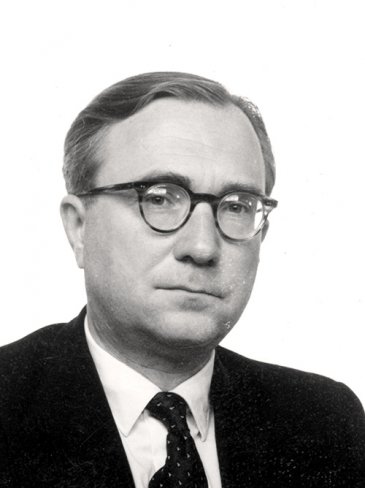
Edvard Hambro (1911-1977). Photo: Stortingsarkivet
Frankly no. I, of course, had close contact with Edvard Hambro from my time at Columbia when he was ambassador to the United Nations and I had a scholarship at Columbia University in New York, but I hardly ever had much knowledge of the interwar efforts. To me, to the extent that I had any knowledge of them, the peace efforts of the interwar years did not seem relevant.
The world had changed fundamentally during World War II. The United Nations had transformed international law and the UN was a profoundly different outfit than the League of Nations. Human rights law had been included as a major purpose of the new organization. It was now a truly global organization through decolonization and in many other ways. The atomic bomb had fundamentally changed the armament problems, and decolonization had dramatically extended the world order to comprise every region of the world. I do not quite see how peace research could build on peace efforts during the interwar years.
I do not think that Johan would have considered these interwar efforts as relevant to his own work; as far as I can remember, he never mentioned them. I have no clue whether he was aware of what they had been doing. My opinion is that he thought of peace research as something entirely novel, and certainly with new methodologies. He was, of course, a most successful academic entrepreneur.
In retrospect, I myself can certainly see the similarities between the PRIO people and those of the interwar years in terms of the urge to contribute to making a better world by means of research and public information efforts. We certainly share the urge to make a personal effort. That, of course, was part of what drew me to PRIO, the individual’s responsibility to be useful, and to make a difference. For me, it was important that the study of law would make it possible to make such a difference.
Thank you very much, Asbjørn.